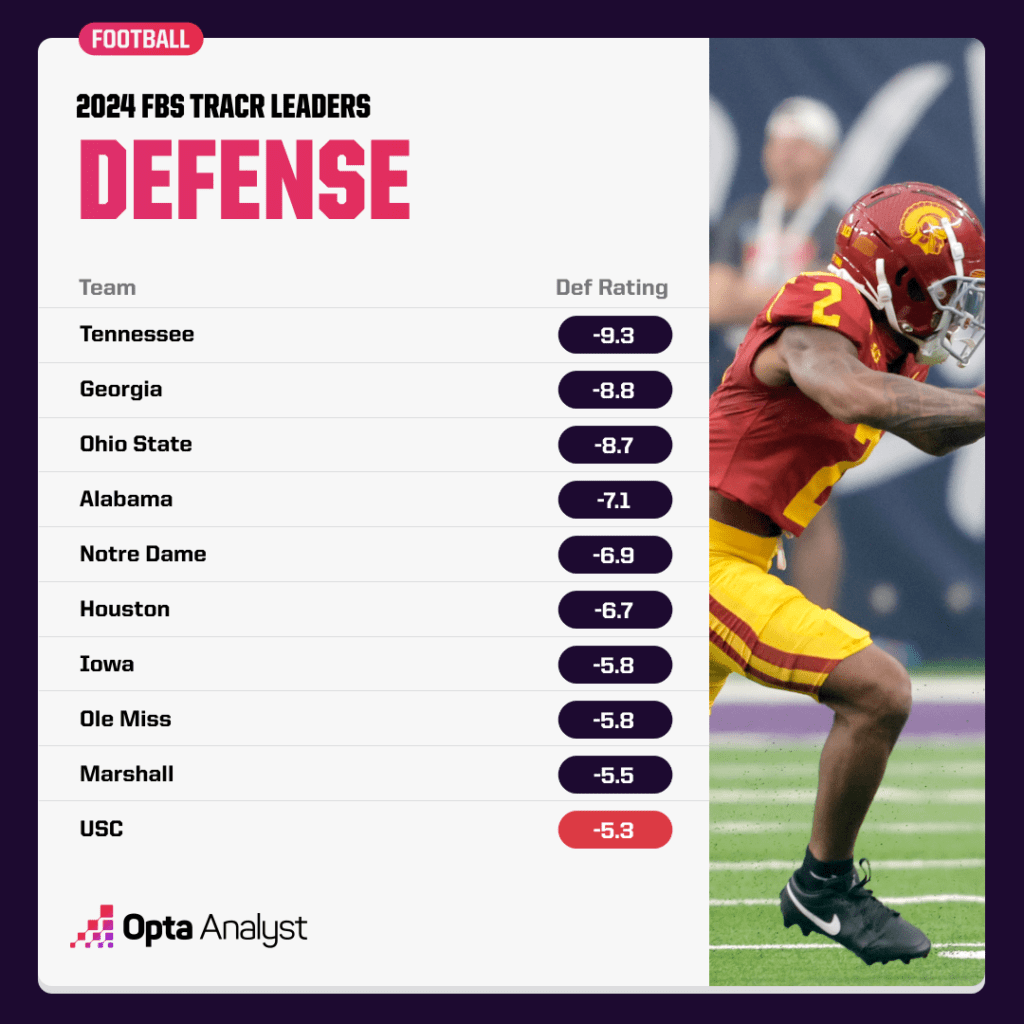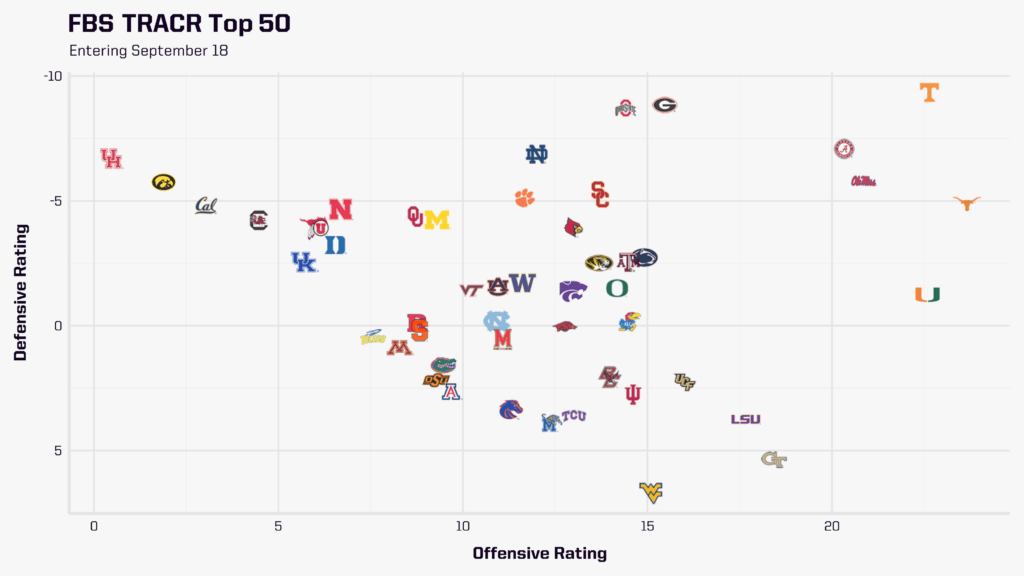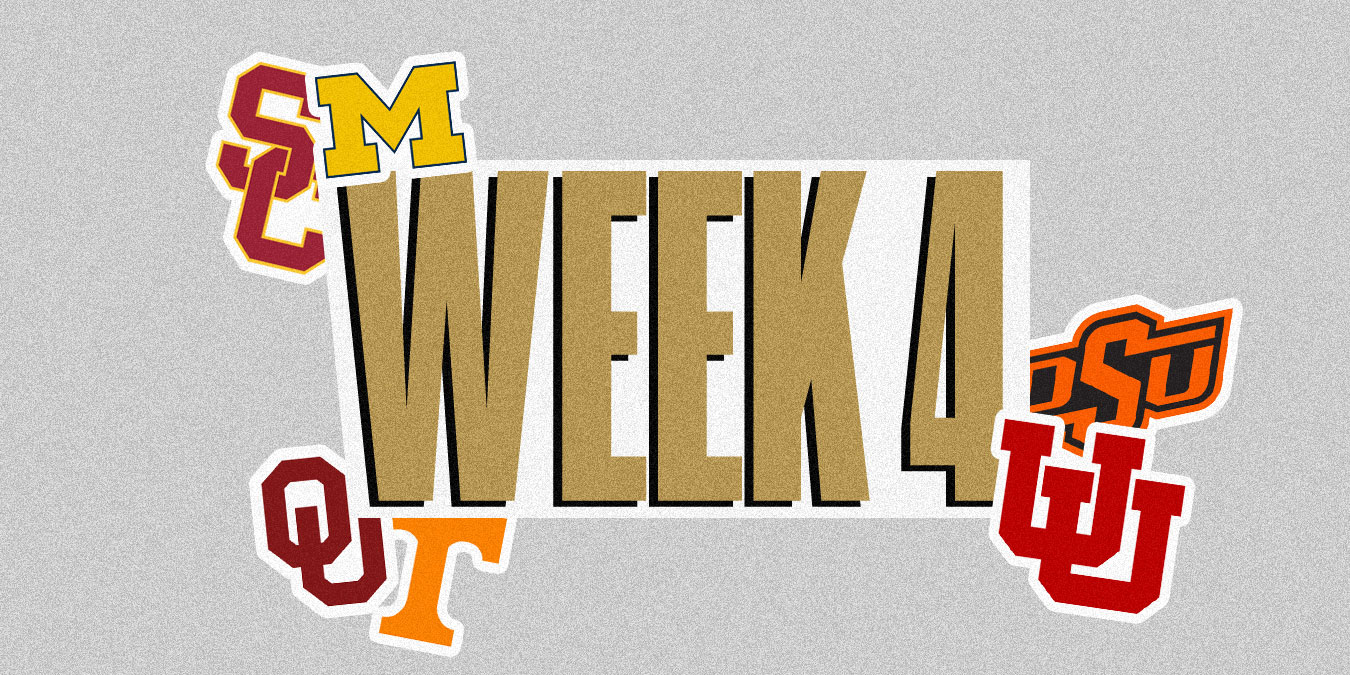Week 4 is a bit more stacked with interesting matchups than last week. We’re breaking down the biggest ones and revealing all our top 25 college football predictions.
The defending national champions are at risk of getting run out of their own stadium by a team that couldn’t stop a nosebleed last year.
Two of the best teams in the new Big 12 meet in Stillwater, but so far, they haven’t been all that good at the things that make up their program identities. Elsewhere in Oklahoma, the Sooners host Tennessee in the glitziest game yet in the recently expanded SEC.
There’s no doubt Week 4 of the college football season is a bit more stacked with interesting matchups than last week.
Opta Analyst’s TRACR model offers its own take on these college football games. TRACR (Team Rating Adjusted for Conference and Roster) is a net efficiency stat that measures how a team should play against a standardized level of competition. The model is based on an EPA (expected points added) calculation weighed by opponent strength.
A team with a TRACR of 0.0 is considered an average team in the FBS. So if a team with a 7.5 TRACR faced a team with a minus-3.0 TRACR, the better team would be a 10.5-point favorite, according to the model.
Here’s how the model sees college football Week 4.
No. 8 (TRACR) USC at No. 20 Michigan, 3:30 p.m. ET Saturday, CBS
Perceptions around this game have shifted rapidly. USC appears to have found a capable defense for the first time in Lincoln Riley’s three seasons, and Michigan has revealed itself to have a dreadful quarterback hole after losing J.J. McCarthy to the NFL.
The Trojans are 5.5-point favorites on the road. They would have been certain underdogs if this were a Week 1 game, but early returns can change a lot.
Michigan, which faces visiting Minnesota in Week 5, will start Alex Orji at quarterback. It’s hard to blame the Wolverines for making a change, given the vast nothingness they were getting out of Davis Warren. In his three starts, Warren tossed four pickable passes (tied for most in the Big Ten), wasn’t used on a single designed run, and averaged just 7.9 air yards per target. (Warren threw six interceptions in those three starts, though Opta Analyst’s game-tracking metrics say that a couple of those weren’t his fault.)
Orji is a blank slate, and Michigan has shown no indication that it thinks he can throw the ball down the field effectively. But when your passing success rate through three games is 35.2% (seventh worst in the power conferences), there’s not much to do but make a change. We’ll see what Sherrone Moore can get out of his new QB.
Last year, the USC defense would’ve been a soft target for a QB making his first start. That might not be the case anymore. Under new coordinator D’Anton Lynn and with a big handful of new players, the Trojans kept LSU to 20 points in their season opener and then shut out a likely bad Utah State in Week 2.
It’s early to call the Trojans a “good,” defense, given that they’ve allowed 5.4 yards per play and a below Power Four-average 38.6% success rate. But they do rank 10th in the nation in defensive TRACR so far and progress is progress.

In particular, the USC defensive front looks much tougher than in the past. The success rate running the ball against USC has been a paltry 23.9% (16th in the nation) and the defense has caused run disruptions 56.6% of the time (22nd nationally).
The pass defense has been spottier but edge rusher Anthony Lucas, with nine pressures in two games, has been one of the sport’s most dominant players.
TRACR’s Win Probability: USC, 65.0%
No. 33 Utah at No. 49 Oklahoma State, 4 p.m. ET Saturday, FOX
Good news first for Utah: The Utes have started their first season as a Big 12 program with three pretty easy wins over Southern Utah, Baylor and Utah State. Tight end Brant Kuithe, a star from 2022’s Pac-12 title team who didn’t play at all last year, has returned to the field and scored a touchdown per game so far.
Nothing has happened yet that says the Utes can’t make a serious run at the Big 12 title and a playoff automatic bid over the next two months.
There are some worrying signs, though. The big one is that quarterback Cam Rising, who missed all of last year, has already missed another game with an injury. It sounds like he’ll play in this one, but Rising’s availability has tended to be a cloudy topic around the program in the past.
Plus, Utah’s downfield passing game hasn’t gelled yet. The Utes are 105th among FBS teams in third-down conversion rate (32.5%) and have been torn up on obvious passing downs in general. Tailbacks Micah Bernard (6.7 yards per carry) and Mike Mitchell (4.5) have been effective, but Utah will probably need more through the air.
Oklahoma State will be a tough out on its home field. The Cowboys have started 3-0 despite not getting much at all from running back Ollie Gordon, a preseason Heisman Trophy contender who has barely been able to get out of neutral. Gordon is averaging 3.2 yards per carry and just 1.4 before contact, both ugly marks for one of the most prolific players in NCAA football.
It’s up to the beholder whether that’s a sign that the Pokes will soon take off (hey, they’re winning without a fully operational Gordon!) or a warning of things to come (maybe the offensive line just isn’t up to the task). The offensive line has allowed a 42.9% run disruption rate, which is a bit below average.
But Utah’s usually excellent defensive front hasn’t quite been itself either, posting just a 34.1% disruption rate, compared to a Power Four defensive average so far of 45.6. The Utes have allowed 3.1 yards per carry overall, including 4.1 against Utah State last weekend.
It’s not been bad, but here’s a weird thought: What if Utah is Gordon’s get-right game?
TRACR’s Win Probability: Utah, 56.9%
No. 1 Tennessee at No. 22 Oklahoma, 7:30 p.m. ET Saturday, ABC/ESPN
There’s a new No. 1 team in TRACR’s ratings, and it’s Tennessee. The eye test has been kind to the Volunteers through three games, and our computer model also sees them as more of a College Football Playoff team than a mere bowl qualifier.
TRACR is so bullish on Tennessee that it would favor the Vols by at least 3.5 points on a neutral field against any other team. (Second is Texas, followed by Alabama, Ole Miss, and Georgia. TRACR loves the SEC right now.)
This matchup is rich with subtext, as Tennessee coach Josh Heupel returns to the program where he was a Heisman runner-up as a quarterback in 2000. Sportsbooks have his team favored by a touchdown.

Tennessee’s splashiest player is redshirt freshman quarterback Nico Iamaleava. The former five-star prospect has been very good across the board to start his tenure as the starting QB. Iamaleava has been slightly above the SEC average in our quarterback tracking stats: well-thrown rate (89.8%) and catchable-ball rate (77.6%) while averaging a league-standard 9.6 air yards per target.
Where he’s been a particular standout is in his few mistakes: Iamaleava’s 1.49% pickable pass rate is less than half the league average. And despite that promising start, the running game is Tennessee’s best offensive trait right now. The Vols are averaging 7.4 yards per run play and have managed a 54.4% success rate on those plays.
Tailback Dylan Sampson has been one of the better players in the country, and a defense with future top-five pick James Pierce rushing off the edge has also been elite to date.
The Oklahoma offense is a dicier proposition, even though the Sooners managed to beat Temple, Houston and Tulane. Their 35.6% rushing success rate is well below the 43.2% average in the power conferences. The Sooners have been almost dead average in yards before contact (3.4) and run disruption rate allowed (40.0%).
The passing game has been an even bigger problem, getting just 5.0 yards per designed pass play. Oklahoma has dealt with injuries to receivers like Nic Anderson and Jayden Gibson (the latter out for the year), and OU receiving targets have posted an ugly 53.4% burn rate so far for quarterback Jackson Arnold. (The Power Four average is 61.7%.)
Anderson could play his first game of the season, and if he does, it won’t come a moment too soon.
TRACR’s Win Probability: Tennessee, 90.5%
TRACR’s College Football Picks for Week 4
- No. 1 (TRACR) Tennessee 90.5% over No. 22 Oklahoma
- No. 2 Texas 99.5% over No. 127 Louisiana-Monroe
- No. 4 Ole Miss 98.2% over No. 109 Georgia Southern
- No. 6 Miami (FL) 93.7% over No. 78 South Florida
- No. 7 Ohio State 94.7% over No. 80 Marshall
- No. 8 USC 65.0% over No. 20 Michigan
- No. 9 Notre Dame 94.0% over No. 98 Miami (OH)
- No. 10 Penn State 99.3% over No. 133 Kent State
- No. 11 Texas A&M 87.4% over No. 81 Bowling Green
- No. 12 Louisville 62.1% over No. 23 Georgia Tech
- No. 13 Clemson 83.1% over No. 72 North Carolina State
- No. 14 Missouri 86.4% over No. 85 Vanderbilt
- No. 16 Kansas 69.6% over No. 40 West Virginia
- No. 17 Kansas State 72.9% over No. 55 BYU
- No. 18 LSU 70.6% over No. 54 UCLA
- No. 21 Washington 78.9% over No. 77 Northwestern
- No. 24 Arkansas 52.1% over No. 25 Auburn
AP Top 25 teams not ranked in the TRACR top 25: No. 12 Utah (at Oklahoma State), No. 14 Oklahoma State (vs. Utah), No. 20 Iowa State (vs. Arkansas State), No. 22 Nebraska (vs. Illinois), No. 23 Northern Illinois (vs. Buffalo), No. 24 Illinois (at Nebraska).
Be sure to check out our MLB, NBA, NFL and CFB coverage. And follow us on X and Instagram for more!
